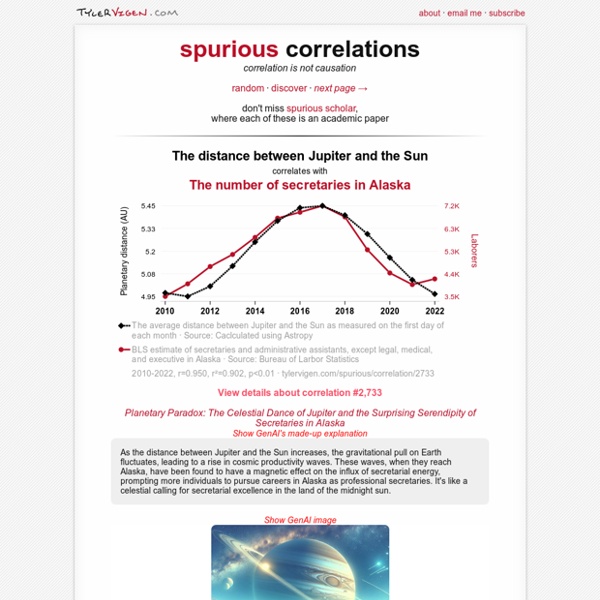



https://www.tylervigen.com/spurious-correlations
Related: Support Readings • Sens critiqueWhen Bars Point Down It’s so simple it feels entirely trivial: bars in a bar chart pointing down instead of up. But the effect can be striking. And it’s not as obvious when to show downward-pointing bars as it might seem. The pure visualization point of view is that bars point up for positive numbers and down for negative ones (or right and left, respectively, for horizontal bar charts). But there is more to it than that when we think about what the graphic conveys beyond just the numbers. We are used to bars pointing up, that’s what we usually see. Why Kids Need Data Literacy, and How You Can Teach It Samantha Viotty’s activity for visualizing data networks has gummy bears representing people and toothpicks signifying their relationships. Photo courtesy of Samatha Viotty Data is all around us, from the output of your Fitbit to interactive maps that track voters to the latest visualization of the New York Times front page. With the rise of mobile devices and wearable technology, data is more available to general audiences, and the amount being generated has also exploded.
The beauty of data visualization - David McCandless To create his infographic about nutritional supplements, it took McCandless a month to review about 1,000 medical studies and design the visual. Is that level of effort surprising, and do you think it’s worth it? Try out the interactive version that’s available on McCandless’s website. What engaged or surprised you? *Write a report. This is no time to be suggesting more work for any exhausted educator. Nevertheless, this is the perfect time to suggest going just one step further. Please write an annual report. Now, more than ever, it matters. For some of you, this is a regular, end-of-year ritual from which you pull on notes, photos, and videos collected over the months. For some of you, this is a task in which you never before engaged.
*SLIDE: data, interactive tools, and an equity wake-up call (Part 1) - NeverEndingSearch We now have the data. Important new research documents concerns relating to the future of our profession and implications for those we serve. The School Librarian Investigation—Decline or Evolution?, or SLIDE research project emphasizes a critical equity issue: our most vulnerable students–those living in poverty, minority populations and English language learners–are those most impacted by declining numbers of school librarians. These losses and their potential impact are a sobering reality, a serious challenge, and a wake-up call. *The SLIDE Study: A chat with Deb Kachel (Part 2) And exploring the interactive data tools - NeverEndingSearch In my last post, I shared news of the School Librarian Investigation—Decline or Evolution?, or SLIDE research project. The study emphasizes a critical equity issue: our most vulnerable students are those most impacted by a declining numbers of school librarians. I recently chatted with project director, Deb Kachel to dig a little deeper into what the study means and her hopes for its impact and use.
*Data Storytelling: How to Tell a Story With Data Over the past few years, data storytelling has taken off. This is not only because data and the role it plays in our lives is increasing. It’s also because storytelling is the way we as humans have always come to understand ourselves and the world we live in. The fact that it shows up in many places and in many forms can confuse some people, so I will help you better understand why it matters and how to make a data story that will help you set and accomplish your goals.
twitter 100 People: A World Portrait An IMLS-Funded Project of the University of Michigan School of Information and University Library